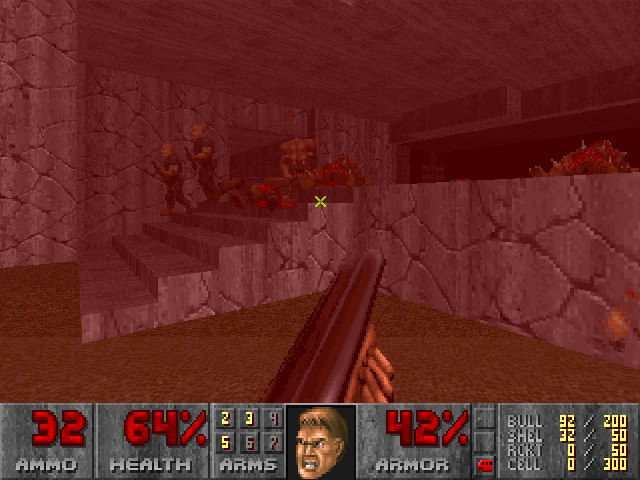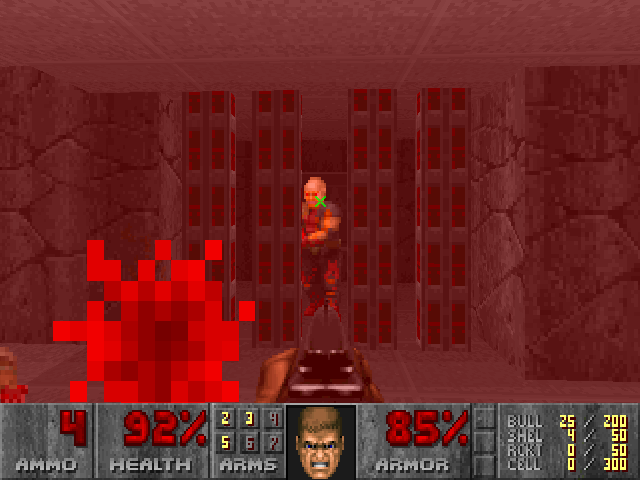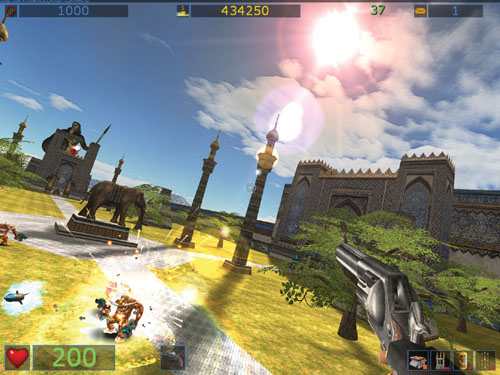User:Grrrreat/research/canopy-draft01
Theme: thinking through images
Update, Final:
Many computer games, especially ego shooters in which the player is supposed to take the
perspective of the avatar, use different types of interfaces and interface effects to create an
immersive atmosphere. Some of these interface elements are obvious and seem rather unreal,
even in the gaming world, such as crosshairs and radar overlays. Others are more sublime
and seem to be simulations of real phenomena such as rapid shutter speeds, lensflares and
explosions in space. These cannot be perceived by humans (lensflares) or are physically
impossible (firy explosions in space). In contrast other interface elements like crosshairs, HUDs
(heads up displays) and laser target markers are already widely used in the real world from
the newest civil technology to the control interfaces of war drones. The 'realistic' effects are
actually taken from semantic realms that we associate with the themes of the games, such as
representations of war, space or medieval knights and castles in other media.
By analyzing examples from these opposing positions, game interfaces and effects and their real counterparts, the project will investigate the semantic realms these phenomena occupy and how we change 'avatars' (our perspectives) to adapt to them. This analysis should also encompass techniques in the traditions of painting ( the pathos formula for example) as well as mainstream cinema and the content of design blogs on the internet.
In times in which visual output has proven to be the prevalent and most efficient form of communication it is necessary to engage in the topic of its vocabularies and how they shape our expectations towards the image. By focusing on the paradoxical states of phenomena in this field one may be able to gain a deeper insight in our actual motivations of accepting, expecting and producing certain visual vocabularies.
Try 1:
Lensflare Paradox.
In many computer games, mainly first person shooters, a series of interface elements and effects is used to make the experience of the game more immersive for the player. These effects usually try to simulate phenomena known from the general semantic realms the individual games take place in, but are at the same time nothing one could ever experience in the real world. So they try to make the experience more real by introducing very unreal elements and therefore distancing the user from the constructed virtual world. The proposed text tries to explore the conscious and unconscious parts of these constructed semantic realms and the implications these phenomena could hold for the perspective of the actual users on themselves.
Try 2:
Many computer games, especially ego shooters, use different types of interfaces and interface effects to create an immersive atmosphere. Some of these interface elements are very obvious and seem very unreal, like crosshairs and radar inserts (HUD in general), some others are more sublime and seem to be something one could think of as simulations of real phenomena like slow shutter speeds, lensflares and explosions in space. But actually these effects are taken from semantic realms that we associate with the themes of the games like war, space and knights and castles. These can actually not be preceived by humans (lensflares) or are just physically not possible (firy and audible explosions in space). In juxtaposition to that things like crosshairs, HUDs and lasermarkers are something already widely used, even though they seem very futuristic and not applicable to the real world when seen in games. The proposed text wants to explore this field and investigate why we see these things as hindering us from this immersive experience and at the same time we expect to have these distancing mechanisms in real life.
Paradoxical state more focus on that. Examples are good. Previosu practice (relation to thinking through images). Representation.
also explain what form it should take.
Maybe go more into MMORPGs, where people spend days, weeks using these interfaces.
Please note that this is still very beta-ish. Feedback annd comments very much appreciated.
Title! (Great Poetic)
Put it in one sentence or two here !
What
Lensflare Paradox consists of an investigation and analysis of effects and interface elements designed to make the experience of ego shooter games more immersive and seemingly real. While these effects seem realistic in their semantic realm, they do and can not apply to the actual physical world. A lens flare for example can only be captured by a camera and not the human eye, still they appear in almost every ego shooter game, where the perspective is supposedly that of the avatar. At the same time things that are regarded as hindering the user from having an immersive or realistic experience like crosshairs, radar and map overlays etc. are actually widely used in the real world, from the newest civil technology to the controls of war drones. The text wants to analyze and investigate these paradoxical phenomena.
How
By analyzing examples from two starting points, game interfaces and effects and their real counterparts the text draws further looking closer at the semantic realms these phenomena reside in and their effects on the expectations we have of an image under certain circumstances. This should not be limited to ego shooters anymore but rather be applied to general semantic realms or different kinds of visual vocabularies.
Why
In times where visual output has proven to be the prevalent and most efficient form of communication it is necessary to engage in the topic of its vocabularies and how they are shaped and being used. By focusing on the paradoxical states of phenomena in this field one may be able to gain a deeper insight in our actual motivations of accepting and even expecting these streamlined and often unlogical forms of visual communication.
This project with the title x is looking at phenomena that often take place in first person perspective (combat) ego-shooters and are usually used for trying to improve the immersive qualities of the game. The project would especially focus on effects that simulate the experience of the Avatar by influencing his visual perception. These effects are sometimes very elaborately programmed, like rain running down the outside (inside) of the computer screen, blood splatter in the face (eyes?) of the Avatar, or lensflares and the likes.
All of these effects are actually not perceivable by the human eye, yet we tend to accept them as something that gives a game a more 'real' edge. Especially in the case of lensflares it seems very paradox because only a camera can 'see' a lensflare because of its complex mechanical composition, yet we know this stylistic element from war movies, not war itself, a world that only war movies give us insight to. Like in the movie 'Saving Private Ryan' which was one of the first ones to employ a very fast camera shutter speed for action scenes in order to achieve some kind of gritty, hyper rela look which again can not be perceived in reality by a bare human eye.
Smoke in early war films, carried on until nowadays aesthetics. More of a simulation of a state of mind. Distraction. fog of war. metaphor made concrete.
Research Methodology. Literature etc.
Photography's claim on the real.
Why do we emply perspectives that are not preceivable to the human eye when we want to depict the hyper real (or just stress the illusion of reality)?
Furthermore: By doing this do we already assume that only a machine could produce/witness this? And what kind of effect (should be more precise i guess) could it have if we assumed our perspective is that of the machine?
Or maybe do we already define ourselves by the perspective of the machine? Am I the camera? Are there any examples for that?
By machine I mean not a machine in a traditional way but more something that has to do with the technical and cultural production of images.
This is all still kind of diffuse and still needs some more definition and a clear objective. Maybe broadening the theme but narrowing down the questions/s would help?
Maybe take the examples just as a starting point for a broader discussion?
The technicalities of getting you closer to the situation are distancing you at the same time.
Games as intesification of the 1987 thought of simultaneousity.
physical objects as metaphors ...
Examples:






